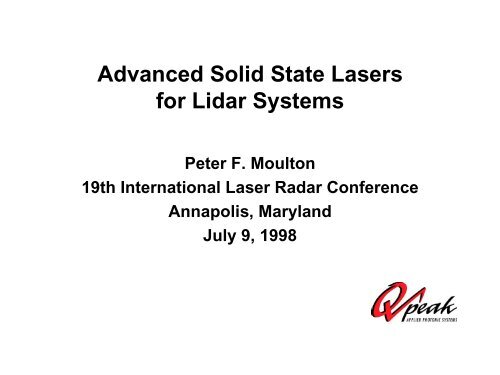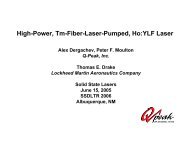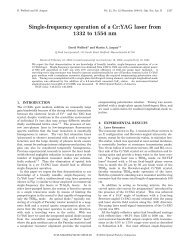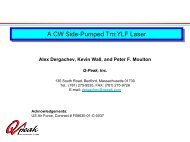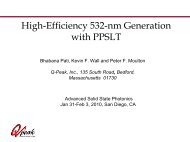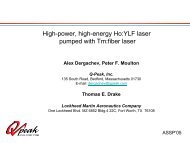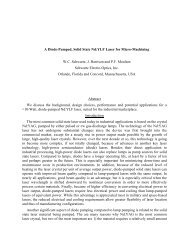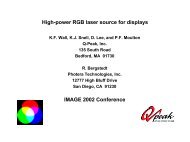Advanced Solid State Lasers for Lidar Systems - Q-Peak, Inc.
Advanced Solid State Lasers for Lidar Systems - Q-Peak, Inc.
Advanced Solid State Lasers for Lidar Systems - Q-Peak, Inc.
You also want an ePaper? Increase the reach of your titles
YUMPU automatically turns print PDFs into web optimized ePapers that Google loves.
<strong>Advanced</strong> <strong>Solid</strong> <strong>State</strong> <strong>Lasers</strong><strong>for</strong> <strong>Lidar</strong> <strong>Systems</strong>Peter F. Moulton19th International Laser Radar ConferenceAnnapolis, MarylandJuly 9, 1998
What is Q-<strong>Peak</strong>???Research Division of SchwartzElectro-Optics, <strong>Inc</strong>.SEO Boston (name change)Q-<strong>Peak</strong>, <strong>Inc</strong>. (wholly ownedsubsidiary)July 9, 1998Ilrc98.ppt
• ResearchersCredits– Glen Rines, Richard Schwarz, Andy Finch, Mark Webb– David Wel<strong>for</strong>d, Jeff Russell, Kevin Wall, Anton Zavriyev,Yelena Isyanova, Kevin Snell, Dicky Lee, Jeff Manni,Alex Dergachev, Bhabana Pati• Collaboration– Ushio, <strong>Inc</strong>. (UV generation)• Government Support– NASA Langley (OPOs, Ti:sapphire UV generation)– NASA Goddard (microlasers)– Army ERDEC (OPOs, Ti:sapphire UV generation)– DARPA (intracavity OPOs)– Air Force (Ti:sapphire, OPOs)July 9, 1998Ilrc98.ppt
Outline• Lamp-pumped, compact Nd lasers• High-energy OPOs <strong>for</strong> eyesafe systems• Ti:sapphire lasers <strong>for</strong> UV generation• Tandem OPO <strong>for</strong> mid-IR generation• CW, diode-pumped lasers <strong>for</strong> next-generationlidar systemsJuly 9, 1998Ilrc98.ppt
Properties of Compact Laser Head (CLH)• Rugged, compact, flashlamp-pumped 1-micron laser• Nd:YLF oscillator / amplifier design• Output: 700 mJ @ 10 - 30 Hz @ 1053 nm (15 ns pulse)• Beam quality: M = 15• Optical head: 5" x 6" x 17", 16 pounds• All optics hard-mounted; final alignment w/ Risley wedges• Power supply & closed-loop cooler in shock-mount cases• Serves as multipurpose pump source– Pump <strong>for</strong> NCPM KTP-family OPOs– Frequency doubled <strong>for</strong> Ti:sapphire pumpingJuly 9, 1998Ilrc98.ppt
Input-Output curves <strong>for</strong> CLH are independent ofpulse rate to 30 Hz1053-nm Output (mJ)80060040020010 Hz20 Hz30 Hz00 20 40 60 80Lamp Energy (J)July 9, 1998Ilrc98.ppt
CLH PhotographJuly 9, 1998Ilrc98.ppt
KTP-family OPOs are used as eyesafe sources• Several crystals belonging to the KTP family, when pumpedby Nd-doped laser pumps around 1050-1070 nm, generatesignal wavelengths around 1550 nm, the maximally eyesafewavelength region• The advantages of the KTP family include:– non-critical phase-matching, which allows good OPOconversion efficiency even with poor-beam-quality pumplasers– large available crystal sizes, which allows generation of highenergiesJuly 9, 1998Ilrc98.ppt
KTP OPO generated a record energy in 10ns pulses1571-nm OPO Output5004003002001004.5 W average power00.2 0.4 0.6 0.8 1 1.21064-nm Pump Energy (J)July 9, 1998Ilrc98.ppt
KTP OPO engineered <strong>for</strong> CLHJuly 9, 1998Ilrc98.ppt
Picture of complete OPO-based lidarJuly 9, 1998Ilrc98.ppt
KTA OPOs generated record powers at 100 Hz3530Signal Power (Watts)25201510500 20 40 60 80 100 120Pump Power (Watts)July 9, 1998Ilrc98.ppt
Biological Standoff Detection System (BSDS)July 9, 1998Ilrc98.ppt
Laser-pumped, high-energy Ti:sapphire laserPump #1Ti:sapphirecrystalsOutputPrismsPump #2GRMHRDeveloped with NASA Langley, DARPA support, 1986-1992July 9, 1998Ilrc98.ppt
Ti:sapphire input-output, 727-960 nmTi:sapphire output energy (mJ)50045040035030025020015010050790 nm727 nm911 nm960 nm00 200 400 600 800 1000 1200 1400Green pump energy (mJ)July 9, 1998Ilrc98.ppt
Harmonic generation extends Ti:sapphirewavelength coverage <strong>for</strong> DIALHarmonic4thNO3rdBenzeneTolueneOzoneCl2HgSO22ndNO2700 750 800 850 900 950Wavelength (nm)July 9, 1998Ilrc98.ppt
Ti:sapphire provides high energies at fundamentaland harmonics• Fundamental (700 - 980 nm region)– > 400 mJ at selected wavelengths• Second Harmonic (350 - 490 nm region):– 250 mJ at selected wavelengths (60% conversion)• Third Harmonic (233 - 327 nm region):– > 40 mJ at selected wavelengths (254, 290 nm)– Currently investigating double-pulse system <strong>for</strong> ozone lidar,improved harmonic conversion• Fourth Harmonic (210 - 245 nm region):– 10 mJ at selected wavelengthsJuly 9, 1998Ilrc98.ppt
Tandem OPO provides broad IR wavelengthcoverage1.5 - 3.6 μmNd-doped,Q-switched laserKTA OPOCdSe OPO3.3 - 11 μmNd-dopedseed laserIR seedsourceIR seedsourceJuly 9, 1998Ilrc98.ppt
Tuning curves <strong>for</strong> Tandem OPO designMustard gasStrong waterabsorptionHClHydrocarbonsCO, HFWavelength (um)1110.5109.598.587.576.565.554.543.532.521.545 50 55 60 65 70 75 80 85 90 95Angle (degrees)CdSe idlerCdSe signalKTA idlerKTA signalJuly 9, 1998Ilrc98.ppt
Input-output curves <strong>for</strong> KTA OPO100OPO pulse energy, mJ80604020Total, 80%R OCIdler, 80% R OCIdler, 96% R OCPump: 1053 nmSignal: 1514 nmIdler: 3456 nm(x-cut crystal)Also:Signal: 1483 nmIdler: 3631 nm(y-cut crystal)00 50 100 150 200Pump pulse energy, mJJuly 9, 1998Ilrc98.ppt
Next-generation lidar sources will be cw pumped• The current generation of solid state lidar sources is basedon lamp-pumped Nd-laser technology• Diode-pumped solid state lasers are more reliable, moreefficient and provide better beam quality per W of outputpower• Diodes are cw devices - they produce essentially the samepower whether pulsed or cw• Generation of high pulse energies requires many diodes -and many $$• The most output per $ occurs <strong>for</strong> cw diode-pumped solidstate lasersJuly 9, 1998Ilrc98.ppt
CW-pumped lidar sources• CW-pumped repetitively Q-switched lasers are common inindustry <strong>for</strong> applications such as materials processing,marking and IC trimming• Diode-pumped, repetitively Q-switched lasers can produce10-20-ns pulsewidths (or shorter) under the rightconditions, and thus providing range resolutioncomparable to pulsed-pumped lasers• For the same average power, the trade-off is that therepetitively Q-switched sources will produce high pulserates and lower pulse energies• More sophisticated signal averaging is needed• Nonlinear devices can work well at the high rates, providingfrequency diversityJuly 9, 1998Ilrc98.ppt
Nd:YLF “Gain Module” uses transverse pumpingNd:YLFcrystalCylinderlens20-WlineararrayCavitymode20-WlineararrayCylinderlensMulti-pass design extracts large fraction of available power inTEM00 mode, has high gainLow average excitation density minimizes stress, beam distortionSimple, single-element pump opticsJuly 9, 1998Ilrc98.ppt
Q-Switching results <strong>for</strong> single gain module show>12 W above 10-kHz PRR714613PULSE ENERGY (mJ)543PULSE ENERGY DATATHEORY (450 us)AVERAGE POWER DATA121110AVERAGE POWER (W)2918071 10 100PULSE RATE (kHz)Note!July 9, 1998Ilrc98.ppt
MOPA #1 design generates higher power19W @ 5kHz25W CW29W @ 5kHz37W CWM2= 1.07 (H), 1.1 (V)Nd:YLF OscillatorGain moduleNd:YLF slab2nd StageAmplifier1st StageAmplifierAOQ-switchDiode Laser barFaradayIsolator11.5W @ 5kHz13.5W CWJuly 9, 1998Ilrc98.ppt
MOPA #2 design uses a two-gain-module oscillator,generates 0.6-MW pulses at 5 kHz50 W CW40 W Q-Sw @ 5 kHz14-ns pulsewidth2nd StageAmplifierCylinderlensTwo-module Nd:YLF Oscillator1st StageAmplifierEOQ-switchCylinderlensJuly 9, 1998Ilrc98.ppt
Two-gain-module oscillator generates 14-ns pulsesat a 5-kHz pulse rate10 ns per divisionJuly 9, 1998Ilrc98.ppt
Harmonic conversion generates visible, UV powerSHG LBO4HGCLBOBBO5HGCLBOBest results:7Oven70SHG (523.5 nm):14 W at 5 kHzand 65% conversionin LBO4HG Average power (W)6543210FHG powerEfficiency0 2 4 6 8 10 12 14 16SHG Average power (W)6050403020100Conversion efficiency(%)4HG (262 nm):6.6 W (internal)at 5 kHz with CLBO2.5 W at 10 kHz in BBO5HG (207 nm):2 W (internal)at 5 kHz with CLBOJuly 9, 1998Ilrc98.ppt
Ti:sapphire laser pumped by doubled Nd:YLF laserhas 44% conversion efficiency at 10 kHz PRR14012010052% slope0.250.2TP (ns)80600.150.1Eout (mJ)40200.05000 0.2 0.4 0.6E in (mJ)July 9, 1998Ilrc98.ppt
OPOs provide high power at eyesafe wavelengthsIntracavity OPOGain moduleNd:YLF slabKTA 25 mm1 W outputat 1507 nmAOQ-switchDiode Laser bar12.5 kHz PRR6 ns pulsewidthExternal OPO43% conversion to 1507 nm6Q-SW PumpSignalKTA 75 mmSignal power (W)543215 kHz PRR00 2 4 6 8 10 12 14Pump power (W)July 9, 1998Ilrc98.ppt
KTA and PPLN OPOs provide longer-wavelength IR• Pump source: MOPA #2• KTA OPO– 60-mm crystal length, 80-degree cut• 30 W pump, 5 kHz PRR• 10 W at 1530 nm, 3 W at 3340 nm– 40-mm crystal length, 60-degree cut• 33 W pump, 5 kHz PRR• 5-6 W of idler tunable from 2300-3000 nm• PPLN OPO– 19-mm crystal length, 30.8-um pitch• 30 W pump, 5 kHz PRR• 5.2 W at 2610-nm idler, 3W at 1720-nm signalJuly 9, 1998Ilrc98.ppt
Closing Comments• The “next generation” solid state lidar transmitters willreplace the lamp-pumped Nd-doped laser “engine” with adiode-pumped Nd-laser “engine”• To be cost-effective (and reliable) the diode-pumped lasersshould be cw-pumped and repetitively Q-switched• A full range of nonlinear optics (harmonic generators,OPOs) and tunable lasers (Ti:sapphire, etc.) are usable withthe cw-pumped “engines” to provide wavelength diversityand tunabilityJuly 9, 1998Ilrc98.ppt


